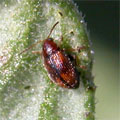Crop production
Soil and climate
Sandy loam soils are well suited for grape
cultivation. Heavy clay soils with more than 50 per cent clay content are
not ideal, but can be managed by providing adequate drainage facilities.
Very shallow soils with hard substratum will pose problem for root
development and uptake of available nutrients. However, in such areas it
is recommended to open deep trenches and filling with soil and mixture of
organic and inorganic manures and fertilizers before planting thus making
soil loose and friable. Grape comes up in soils of wide pH range (5.0 to
8.5). Supplementation of zinc and iron is essential in heavy black soils
with high pH range which are known to cause lime induced cholorosis. Supplementing with boron in sandy loam soils is also advocated to overcome
its deficiency. Grape is moderately sensitive to salinity and therefore,
it is better to avoid soils with EC values more than 2 dSm-1 and one that
have more than 8 to 10 per cent sodium in soil exchange complex. Chlorides
in soil solution with 8-10 me / l is likely to cause specific toxicity to
grapes grown on own roots. However, with the advent of rootstocks like
Dogridge, one can grow grapes in saline soils having chlorides up to 18 -
20 me /1 in soil solution as Dogridge rootstock has the capacity to
exclude chlorides from soils.
Grape can be grown successfully where warm and dry weather prevails. This
type of weather is prevalent in southern parts of the country where the
temperatures range from 15-40°C and annual rainfall amounts to 50 - 80 cm.
The distribution or spread of rainfall is important for prosperous grape
growing. Rains should not coincide with the fresh growth after pruning or
during fruit ripening. Cloudy weather, high humidity, low temperature and
precipitation during flowering and berry development are detrimental as
this type of climate is highly congenial for the spread of fungal
diseases, to which grape is highly susceptible.


